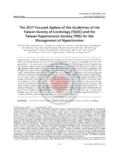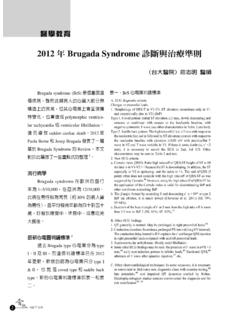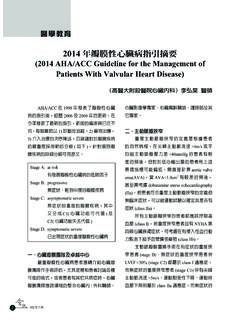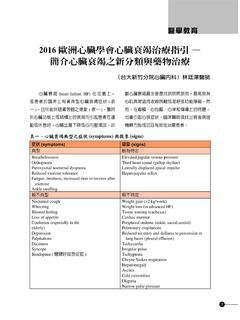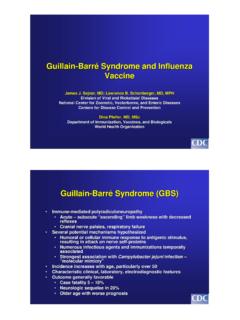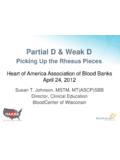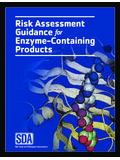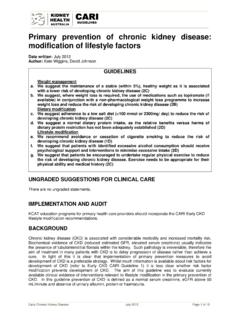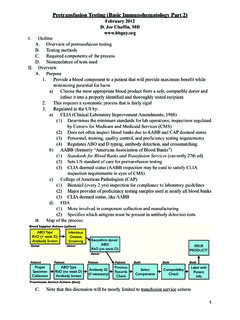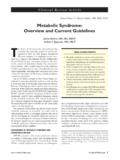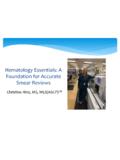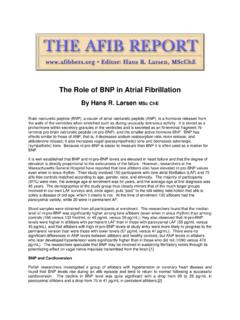Transcription of Congestive Heart Failure C-Reactive Protein Levels in ...
1 Congestive Heart FailureC-Reactive Protein Levels in ChronicCongestive Heart FailureWen-Pin Huang, Wei-Hsian Yin, Hsu-Lung Jen, Meng-Cheng Chiang, An-Ning Feng and Mason Shing Young1 Background:Serum concentrations of C-Reactive Protein (CRP) are elevated in patients with Congestive heartfailure (CHF). However, clinical data about the prognostic value of CRP Levels in patients with chronic stableCHF are sparse. We hypothesized that measurement of CRP might provide prognostic information in :We measured serum Levels of CRP in 72 patients with chronic CHF and left ventricular ejection fraction(LVEF) < 50%. Major adverse cardiac events (death or hospitalization with worsening CHF) during a medianfollow-up period of 449 days were determined.
2 Multivariate Cox regression analysis was performed to identifyindependent predictors of major adverse cardiac :The concentrations of CRP in the sample population were significantly increased with the severity of 25 patients who had adverse events had significantly higher CRP Levels (p= ) than the 47 patients whowere event-free. We further divided the 72 CHF patients into tertiles on the basis of this sample, with the cutoffpoints for each tertile being , > to , and > mg per liter, respectively. The differences betweenevent-free curves were insignificant between tertiles 1 and 2 but were significant between tertiles 1 and 3 andbetween tertiles 2 and 3 (p= ,p= , respectively).
3 In a multivariate analysis (n= 58), left ventricularend-diastolic pressure (LVEDP) and serum Levels of CRP > mg per liter were found to be independentlysignificant predictors for major adverse cardiac events in patients with chronic CHF. The CRP Levels weresignificantly correlated with LVEDP (r= ,p= ;n= 58).Conclusions:These findings suggest that the Levels of CRP are related to clinical outcomes and that measurementof CRP has the potential to play an important role as an adjunct for risk assessment in patients with chronic Words: C-Reactive Protein Congestive Heart Failure PrognosisINTRODUCTIONA ctivation of the immune system has been implicatedin the pathogenesis of Congestive Heart Failure (CHF).
4 1,2 Cytokines such as tumor necrosis factor alpha (TNF-a)and interleukin-6 are significantly elevated, producingnegative inotropic effects on the Heart , and the Levels ofthese cytokines may be negatively associated ,3C-reactive Protein (CRP), as a marker of inflamma-tion, has been shown to be associated with an increasedrisk of various cardiovascular serumconcentration of CRP is also elevated in patients withcongestive Heart Failure (CHF),8-10and Gottdiener et that increased CRP was an independent predictorof incident CHF in a community-based elderly , clinical data about the prognostic value of CRPin patients with chronic CHF are sparse and ,10 The likely reason for this is that the mildly ele-vated CRP concentrations in these patients fall wellwithin the range found in healthy subjects, and the stan-dard clinical assays for CRP lack sensitivity within the7 Acta Cardiol Sin 2004;20:7-14 Original ArticleActa Cardiol Sin 2004.
5 20:7-14 Received: April 29, 2003 Accepted: October 7, 2003 Division of Cardiology,1 Department of Internal Medicine,Cheng-Hsin General Hospital, Taipei, correspondence and reprint requests to: Dr. Mason ShingYoung, Department of Internal Medicine, Cheng-Hsin General Hospital,No. 45, Cheng-Hsin Street, Taipei 112, Taiwan. Tel: 886-2-2826-1242; Fax: 886-2-2826-1242; E-mail: range: thus they cannot be used effectivelyfor cardiovascular risk prediction. Since high-sensitivitycommercial assays for CRP are now available,12we hy-pothesized that measurement of CRP might provideprognostic information in these study was designed to evaluate the level of CRPusing high-sensitivity kits in patients with chronic CHFand to examine the relation between the degree of CRP el-evation and clinical populationSeventy-two patients (48 men and 24 women, aged46 to 76 years [mean 61 15] with chronic CHF wereenrolled.)
6 Patients were included if, at the time of enroll-ment, they had New York Heart Association (NYHA)class II to IV symptoms of Heart Failure and a left ven-tricular ejection fraction (LVEF) of < 50% by leftventriculography with radionuclide or contrast all patients had low LVEFs, they had all beenclinically stable without signs or symptoms of pulmo-nary congestion for at least two weeks before their entryinto this study. Patients were excluded if there was se-vere comorbidity, renal Failure , myocardial infarction orunstable angina in the 6 weeks leading up to enrollment,leukocytosis (WBC count > 10000 per deciliter), infec-tion or an inflammatory illness such as sepsis,malignancy, arthritis or connective tissue age-matched group of 16 volunteers provided bloodsamples for use as a control.
7 All of these subjects were freeof Heart disease and other major medical clinical evaluation and hemodynamicmeasurementsBaseline clinical evaluation was performed on the 72patients with CHF. Sixty-nine patients underwent cardiaccatheterization or coronary arteriography for clinically in-dicated purposes. Informed consent was obtained from allpatients according to a protocol approved by the commit-tee on human investigation at our institution. Left-sidedcardiac catheterization, including left ventriculographyand coronary arteriography, was performed in 58 cardiac catheterization, both with and withoutendomyocardial biopsy, was performed in 13 and in 41patients, respectively.
8 Right Heart pressure, such as pul-monary capillary wedge pressure, was measured with a7Fr Swan-Ganz catheter, and cardiac output was mea-sured by the thermodilution LVEF was determined by left ventriculographywith standard radionuclide or contrast sampling and measurement of circulatinglevels of CRPFor those 54 patients who underwent right heartcatheterization for clinical (noninvestigational) evaluation,venous blood was drawn during right Heart catheterization(central vein). For other patients, blood samples were col-lected into vacuum tubes at bedside (peripheral vein). Allsamples were then frozen to 20 C and were stored atthat temperature until analysis.
9 The time interval betweenblood sampling and LVEF studies for every patient wasless than one were assayed for CRP with a validated,high-sensitivity assay (DRG Instruments, Germany). Theintra-assay and inter-assay coefficients for each factorwere about 5% and about 10%, follow-upAll patients were followed either in-hospital orthrough regular outpatient visits. Clinical information re-garding major adverse cardiac events (cardiac death orhospitalization with a primary diagnosis of worseningCHF) during a median follow-up period of 449 days wasprovided by the treating cardiologist without knowledgeof the CRP analysisAll values, except for the CRP level, were expressedas mean SD.
10 Because the distribution of the CRP levelsin these patients did not follow a normal distribution, theywere expressed by a median (25thto 75thpercentiles).The patients with CHF were divided into two groups:mild CHF (NYHA class II) and severe CHF (NYHA classIII or IV) groups. Comparisons of the Levels of CRPamong these 2 groups and the controls were determinedby means of a Kruskal-Wallis one-way analysis of vari-ance on ranks CHF patients were then divided into those whohad major adverse cardiac events during follow-up andthose who were event-free. Univariate comparisons ofclinical and hemodynamic characteristics between thesetwo groups were made with the Student s t test for quanti-Acta Cardiol Sin 2004;20:7-148 Wen-Pin Huang et data and with the Fisher exact test for qualitativedata.

